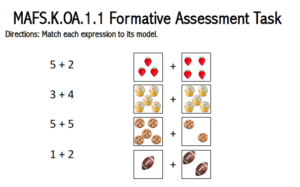MAFS.K.OA.1.1: Represent addition and subtraction with objects, fingers, mental images, drawings, sounds (e.g., claps), acting out situations, verbal explanations, expressions, or equations.
Cognitive Complexity Level: 1-Recall
[divider] [/divider] Students are able to…
- Explain addition and subtraction with objects, fingers, drawings, sounds, acting out situations, or verbal explanations.
- Recognize vocabulary of addition (joining two sets or adding on to a set) and subtraction (taking items from a set or taking apart a set).
- Match models with expressions and equations provided by teacher.
[divider] [/divider] Students are able to…because teachers
- Introduce appropriate addition and subtraction vocabulary. NOTE: Vocabulary should be focused on the actions, not key words!
- Addition: add, put together, join, combine, plus
- Subtraction: take away, minus, subtract, take apart, separate
- Provide opportunities for students to compose and decompose numbers up to 5 using concrete materials.
- Ask questions that promote student explanation using both words and pictures
[divider] [/divider] Questions to ask students:
- What is the action in the problem?
- Sample answer that indicates understanding: putting together, joining, adding to, taking from, separating, etc.
- How do you know you are putting together, joining, or adding to?
- Sample answer that indicates understanding: Students are able to correctly identify the action in the problem. Consider the problem, “There are 2 students at the water fountain. Two more get in line. How many students are in the water fountain?” Student should be able to identify the action is adding to.
- How do you know you are taking from or separating?
- Sample answer that indicates understanding: Students are able to correctly identify the action in the problem. Consider the problem, “Joseph is holding 4 crayons. Miracle takes one. How many crayons does Joseph have now?” Student should be able to identify the action is taking from.
[divider] [/divider] Additional Resources:
Additional in depth content knowledge
Blog Post:
Joining and separating… using actions to understand addition and subtraction
Video:
ORIGO: Exploring add-to addition
ORIGO: Introducing types of subtraction
[divider] [/divider] Sample Formative Assessment Tasks:
[divider] [/divider] Resources/Tasks to Support Your Child at Home:
- Use small objects around the home (dry beans, Cheerios, etc.) and have your child model simple addition and subtraction problems using the small objects.
Questions to ask your child:
- What is the action in the problem?
- How do you know you are putting together, joining, or adding to?
- How do you know you are taking from or separating?
- http://goo.gl/xksa1n This interactive site allows students to practice addition and subtraction.

